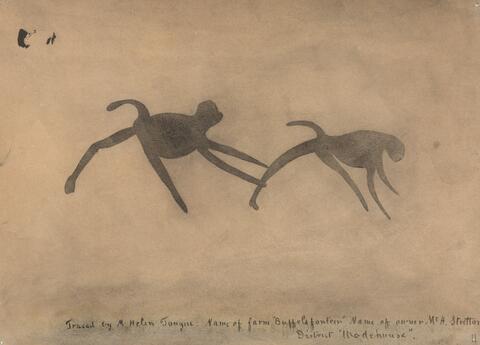Identity area
Reference code
Title
Date(s)
- Unknown (Creation)
Level of description
Extent and medium
Context area
Name of creator
Biographical history
Name of creator
Biographical history
History of the collection
The Tongue collection is currently split between two Institutions. The final colour copies, just over 100 in total, including those that were exhibited and published, are stored at the Iziko Museums of Cape Town. Tongue's original tracings and line drawings (some derived directly from Stow copies) are housed at the Rock Art Research Institute. A large number of these had originally been donated to the Pitt Rivers Museum in Oxford in 1921, but these were returned to the Rock Art Research Institute in South Africa in 1990s thanks to the farsighted vision of Professor Ray Inskeep. Read Less
Background of the Recorder
M. Helen Tongue was a school teacher at Rockland Girls' High during the 1890s and 1900s in the town of Cradock in the Eastern Cape, South Africa. It was here that she met Dorothea Bleek, daughter of famous San linguist and ethnographer, Wilhelm Bleek. The two travelled widely visiting rock art sites in the region. Tongue developed a direct contact tracing technique to record each image (both painted and engraved) in its exact proportions and in its relationship to other images as they appeared on the rock surface. In this way, she took an important step beyond the pioneer recording work of George Stow. Tongue's Eastern Cape copies are her earliest. Her first copy was made on a farm in Molteno District. In this early work, she worked alone. But, the bulk of her copies were made during three longer fieldtrips beyond the Eastern Cape border, together with Dorothea Bleek. At the beginning of 1906, Tongue and Bleek made a train trip from Cradock to Bloemfontein and Ladybrand (Free State), where they recorded various rock art sites. Most of the sites visited were located by using the descriptions of George Stow. A second expedition in the summer of 1906/07 took them through the Eastern Cape and into Lesotho. Their third and final expedition was by train to Fauresmith (Free State) and wagon to Luckhoff in the Karoo (Western Cape). In 1908 a selection of Tongue copies were exhibited at the South African Public Library in Cape Town and then at the Royal Anthropological institute in London. In 1909 a series of copies were brought together in a handsome portfolio of 54 plates and an accompanying book with two collotype plates and eight black-and-white photographs. Helen Tongue wrote descriptions for each site and each plate, Dorothea Bleek contributed "Notes on the Bushmen" and Henry Balfour wrote a preface. The book was titled "Bushman Paintings", it was Tongue's first and only rock art publication
Repository
Archival history
Immediate source of acquisition or transfer
Content and structure area
Scope and content
Baboons are painted and engraved more frequently than jackals, and they also feature more frequently in Bushman myth and folklore. The /Xam believed that, like the lion, the baboon had similar powers to those of shamans. It was supposed to draw these powers from a small stick of a plant, which it kept in its left cheek. Some depictions of baboons show a whole troop with males, females and babies. There are also therianthropic baboons which express the closeness of baboons to people and, more important, the association between baboons and shamans.
Appraisal, destruction and scheduling
Accruals
System of arrangement
Conditions of access and use area
Conditions governing access
Conditions governing reproduction
Language of material
- English
Script of material
Language and script notes
Physical characteristics and technical requirements
Original size: 27.5 x 19.78cm

